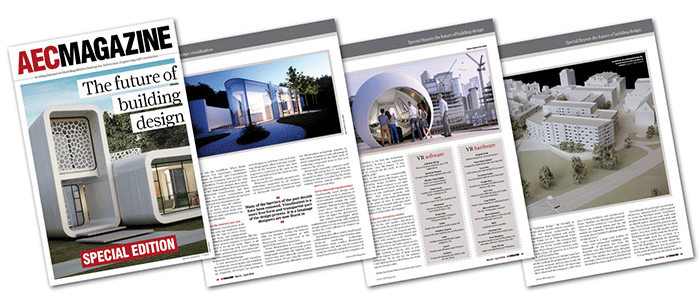Our industry is changing at an ever increasing rate. Technology is playing a major role in this change, but the message has become muddied, confused to a point where a series of three-letter acronyms have become more important than the change they are intended to bring.By Nigel Davis
Everyone has heard of the UK Government mandate for all public projects to be delivered using BIM by 2016. If you have not, it is time you climbed out from under that rock and woke up to the industry that you rely on for your livelihood. What is not really understood is how this relates to the “average” company, which may or may not be involved in any type of public project. That is not surprising as most of the people who are directly affected by this mandate spend so much time debating and arguing terminology the majority of the industry get on with their “business as usual” activities.
In 2015 57.6% of all British construction related business employ less that 20 staff according to the Office for National Statistics. It could reasonably be argued that is over half of the industry which views many of these drivers as being irrelevant to their business. The same is certainly true of some larger practices as well, 81.8% of which employ below 100 people. There is simply no incentive to change. But, as Heraclitus stated way back around 500BC, “Everything changes and nothing stands still.” Change we must.
Part of the problem in the construction industry is that this change is presented as major differences to every aspect of a company’s working methods. This is simply not an achievable target for the majority, and hence why the adoption of “recommended processes” has not been as widely seen as hoped.
For any company to move forward with new, alien ways of working, a large revolutionary change needs to be broken down into a series of smaller evolutionary steps, where small changes can be balanced against improvements in efficiency, removing the risk, perceived or actual. To achieve that, you may actually have to go against the ‘BIM spin’ perpetuated by the industry at large and work in an infamous ‘silo’ in order to be able to attain the end goal.
As a small practice, the first step is to review your digital production (CAD) software. Tools have traditionally been selected based on price, and hence why seats of AutoCAD LT are far more prevalent that others (presuming we are only talking legal licenses for now). That is always going to be the case, but cost alone cannot be the only factor. Like it or not, the requirements of information exchange with the rest of the design team have moved on, if not the demands of clients. Software needs to be able to deliver so much more than it once did. The base requirement for production tools now needs to be 3D; if your tools are not capable of delivering this, expect to see, at best, additional hours spent trying to deal with others’ 3D models; at worst a downturn in work as project teams expect 3D capabilities.
Understanding the relationship between 3D co-ordination and drawing production is the important second step, as these are two separate but intrinsically linked tasks now expected in the 21st Century construction market.
Your tools need to be capable of avoiding information duplication. With fee structures as they are, no-one can afford to duplicate their workload. Learning 3D is not usually an onerous undertaking. Most of the widely available tools are both reasonably cheap and can be learned easily with only a short time on YouTube. It is the principle of modelling first and documenting second that needs to be embraced.
Many of the more expensive tools are now offering cheaper starting points, which puts this technology well within the reach of smaller practices. ArchiCAD Star(t) Edition, Revit LT, Vectorworks, even SketchUp Pro are all worth investigating further and can be utilised in many different disciplines. Those software developers who only offer “Rolls Royce” solutions need to rethink their business model to allow for the wider industry as well. The same 57.6% of comOur industry is changing at an ever increasing rate. Technology is playing a major role in this change, but the message has become muddied, confused to a point where a series of three-letter acronyms have become more important than the change they are intended to bring. Forget BIM About the author Nigel Davis, director of Evolve, has 20 years’ experience in the AEC industry with insight into cutting-edge design and construction data production and exchange. by Nigel Davis Benefits of 3D design Special Report: the future of building design www.AECmag.com March / April 2016 19 Take small sure steps instead of trying to leap across the chasm panies who employ less than 20 people are responsible for 38% of total construction value. Is that a market anyone should be ignoring? But I digress…
At this point wider collaboration should not be so much of a concern as implementing a solution that can improve your own internal working methods. Do not become overly concerned either about everything you hear about needing data, metadata or non-graphical information, all these things can come later. Concentrate initially on the ability to be able to model once and from that produce 2D documentation and changing the way you approach the project.
Working in this way also means you bypass any arguments about how to ‘validate the 3D model’ as drawing checks and sign-offs can carry on as they always have done: signing the drawing can be used to validate the model that produced it. Again, it is about evolution, not revolution. Using the model to produce schedules or specifications becomes easier, almost an added value free activity, step once this
The same thought process should apply to your other office procedures and protocols. Just because a company is small, it does not negate the need for consistent working methods and quality. CAD has caused as many problems as it resolved, particularly in regard to timeframes and checking. Fees too have had a detrimental effect on the quality of construction information, but if we, as an industry and as individuals, are to have any hope of achieving better projects, we need to allow adequate time in the programme for checking, eradicating errors before they become costly construction delays.
CAD has led us to a point where generically it is assumed everything is correct; we must return to the tenet of everything being incorrect until it has been ratified, regardless of how it was produced. It is unlikely we will realise the promised cost reductions, or certainly not in the short- to medium term, but what we should all be capable of is delivering a better product at the same cost. This mindset needs to extend to everyday procedures:
Project folders should always be consistent and simple. Adding additional folders seems like a sensible thing to do at the time: you need a new set of documents or models, so you put them in a new folder. But it is a basic rule of filing that the more places you have to store a file, the more places there are to misfile it. Or duplicate it.
File naming too should be consistent and simple. Keep to the same convention on every project. That way you’ll be able to track what you need down at any time, be it now or in five years’ time
Understand your typical deliverables. Not only in terms of what drawings or documents you expect to release and when, but what other people use that information for. If you understand why people need your work, you can forget all this waffle about collaboration, you are already doing it.
None of this is rocket science, none of this has to be labelled ‘BIM’. This is good design and good construction practice. These are the bare essentials needed for remaining competitive in the modern construction industry.
Change is certain, progress is not. You need to embrace the changes, but do so on your own terms, in your own time, taking small sure steps instead of trying to leap across the chasm.
Forget BIM, concentrate on your business, and one day you will unlock the office door to find you are delivering everything you need to without even realising that you have made the journey.
About the author
Nigel Davis, director of Evolve, has 20 years’ experience in the AEC industry with insight into cutting-edge design and construction data production and exchange.
This article is part of an AEC Magazine Special Report into the Future of Building Design, which takes a holistic view of the technologies and processes, which are set to change and enhance the AEC industry in the coming years — from concept design all the way to construction.
Click to read the other articles that make up the report.
1) Introduction New technologies are empowering architectural firms to improve quality, capabilities and process.
2) Conceptual design There are a whole host of digital tools for early stage design experimentation.
3) Rapid site design The rapid capture of site topology is being aided by new technologies.
4) Benefits of 3D design Evolution, not revolution when making the move to 3D CAD.
5) Moving to model-based design How to get from 2D to 3D, how to roll out training and how to overcome common issues encountered along the way.
6) Design viz Advanced new rendering technologies are opening the door to design realism in architectural workflow.
7) Design, analysis and optimisation Once you have a 3D CAD model, optimse your design for daylighting, energy performance and much more.
8) Collaboration and model checking How to share models with clients, contractors and construction firms and test the quality of your model.
9) Workstations What to look out for when choosing a workstation for 3D CAD.
10) Virtual Reality New technologies are now available to support powerful new design workflows.
11) 3D printing Architects are 3D printing architectural models with impressive results.
12) Fabrication As building time gets compressed what will revolutionise fabrication and construction time?

If you enjoyed this article, subscribe to AEC Magazine for FREE






